Puppy training: the best tips to get started
- Claudia Weise
- Updated: 2023-06-15
You have a fluffy, cute puppy at home? The first time with a puppy can be fascinating and challenging. In this article, you'll find the best tips for properly raising your new four-legged friend.
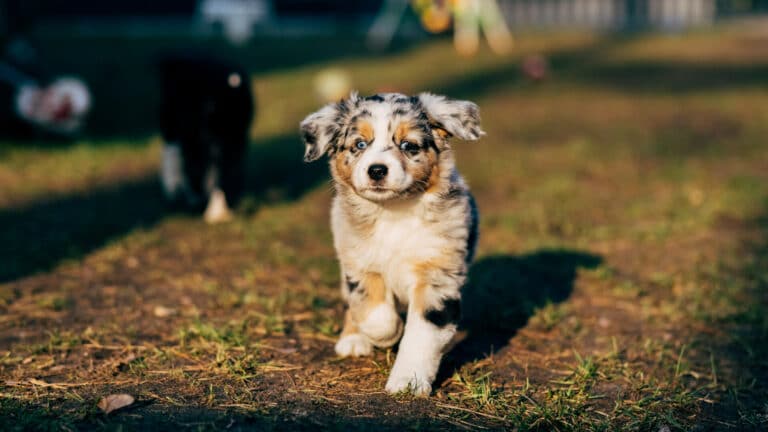
The basics
It is never too early to start training. Puppies are particularly receptive and eager to learn when they are young. The basics of puppy training include several aspects. Here are the most important:
Why education from the puppy is so important
A new puppy brings a lot of joy and excitement to the home, but also a lot of responsibility. As a new dog owner, you should know that successful puppy training requires patience, consistency and a lot of love.
Remember that it is an important time for the bond between the two of you.
Raising a puppy is very important for several reasons:
Education gives your puppies confidence. By learning basic commands, the dog can be better controlled in potentially dangerous situations. For example, a command like "Stay" can keep the dog from crossing a busy street.
Good socialization helps the puppy to adapt to different environments, people and animals. This is important to prevent anxiety and aggressive behavior that can develop when dogs are not sufficiently socialized.
Early training helps build a strong bond between you and your puppy. Through training, your puppy learns to trust and listen to you, which strengthens the bond between you.
Early and consistent education can help prevent or minimize behavior problems. These include problems such as excessive barking, chewing or aggression.
A well-behaved dog is easier to integrate into everyday life, whether at home, visiting friends, or in public spaces such as parks and cafes.
Finally, a good education leads to a better quality of life for the dog and his family. A well-trained dog can move freely and safely, and its owners can enjoy the company of their pet without constant fear or frustration.
Overall, raising a puppy is an investment in a lifelong friendship and allows you to raise a responsible, happy and well-adjusted dog.
Short Training Sessions
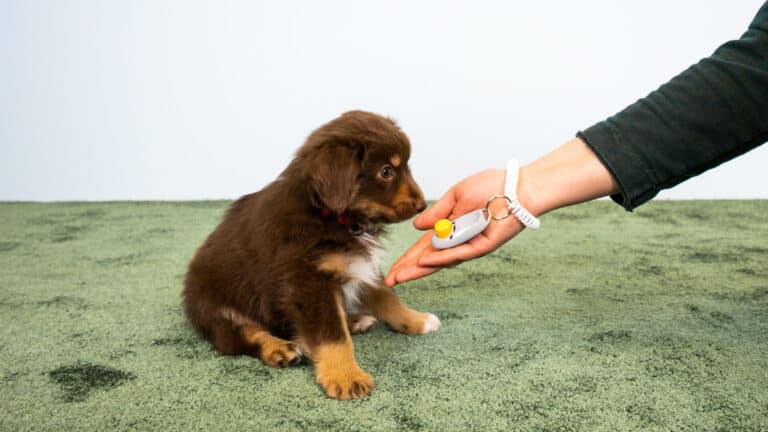
Puppies have only a short attention span. Therefore, it is better to do several short training sessions per day than one long one. Train several times a day in short 5 -minute sessions. So keep the training short and simple. Make it positive, it should be fun. This way your dog can process and internalize what he has learned in the best possible way. Always end the training positively.
Rewards
Do not forget the positive reinforcement
Rewards, such as treats, praise and petting, or talking in a friendly voice are more effective training methods than punishments. They encourage good behavior and strengthen the bond between you and your puppy.
- Treats: Small, light snacks or "super treats" like sausage and cheese are great rewards for puppies because they give them instant gratification and are easily associated with positive actions. Make sure the treats are healthy and appropriate for puppies.
- Praise: A simple "Good job!" or "Good dog!" can be an effective reward for your puppy, especially if said in an excited and happy voice.
- Playing and petting: For many puppies, a short game or a loving petting session is the best reward. This can be especially effective when there is no treat on hand or when you want to prevent the puppy from becoming too dependent on treats.
It is important to reward your puppy as soon as he has shown the desired behavior. Don't wait too long or he won't be able to associate the reward with his behavior.
Reward your puppy every time he successfully performs a command, especially the first time he gets it right.
To encourage good habits: Reward your puppy when he exhibits good behavior on his own, such as cleaning up his toys or sitting quietly when visitors arrive.
By rewarding your puppy in this way, you help him build a positive association with good behavior and commands, which makes training more effective and strengthens the bond between the two of you.
Start with the basic commands
There are some basic commands that your puppy should learn first. They are simple enough for a puppy to understand and form the basis for successful communication and safe behavior throughout his life. Here are some of the most important commands you should teach your puppy:
- "Sit": This is often the first command taught to a puppy. It is useful in many situations, for example, when you want your puppy to stay calm while you prepare his food.
- "Stay." This command is especially important for your puppy's safety. For example, it can teach him to stop at a busy street.
- "Here." or "Come": With this command you can call your puppy to you, which can be useful in many situations. It is especially important to practice this command in a safe, fenced environment until your puppy reliably obeys it.
- "No" or "Off": This command is helpful to stop unwanted behavior, such as your puppy chewing on your shoes.
- "Place: The "place" command teaches your puppy to lie down. This is especially useful for calming your dog or getting him to stay in one place.
In the following articles we will show you how to practice the basic commands with your puppies. Just take a look!
Keep training simple
Use simple words like "sit" or "down" and always use the same words and tone for the commands. Take one or more steps back if your dog gets stuck. This is how your puppy learns through repetition.
Do not talk too much during training. The only important things are the sound signal and the reward. Also, do not practice too many commands at the same time. Your puppy should not be overstrained. If your dog does something wrong, be consistent and firm, but please do not yell.
Be consistent
Whether it's commands, feeding times or boundaries in the house, consistency is key. If you allow a behavior one time and then forbid it the next, it can be confusing for your puppy.
When training your puppy, it is important to be patient and always use positive reinforcement. Each dog learns at his own pace. It's important to think of training as a way to bond and have fun - not just a learning exercise.
Remember to keep training short, as puppies have a short attention span, and don't forget to reward them after each successful training session.
The socialization
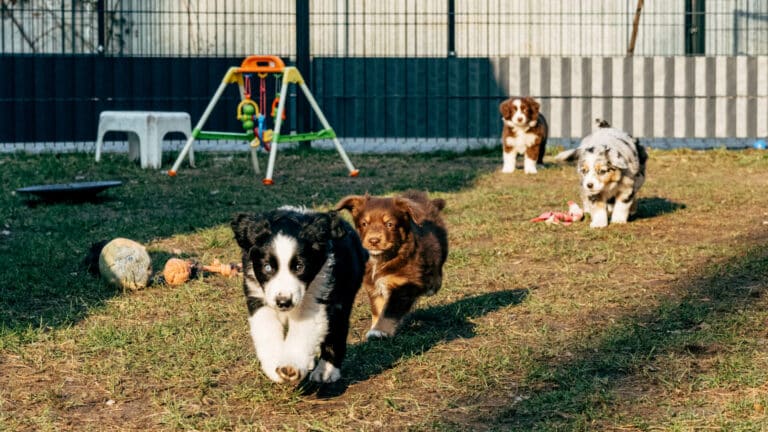
Provide social interaction: It is important that your puppy learns to interact with other dogs and people. Schedule playtime with other dogs and make sure your puppy has lots of positive interactions with people.
Go out in public early. Meet other dogs and people while doing so. Ride public transportation so your puppy gets used to it early. Go to puppy school to meet other dogs and learn many other things.
In this article you will find information on whether puppy school is useful:
Puppy School: Yes or No? (Is it worth the effort?)
Set boundaries
Setting boundaries is an important part of raising a puppy. It helps him build confidence and trust and understand what is expected of him. Here are some tips on how to set boundaries for your puppy:
Consistency is the key to setting boundaries. If you want your puppy to follow a certain rule, you need to be consistent. For example, if the sofa is off limits, it should always be off limits, not just sometimes.
Use simple, clear commands to tell your puppy what he should and should not do. If he does something you don't want him to do, say "No" in a firm but friendly tone.
The education
Now we come to specific puppy training tips from which you, as an owner, can choose the ones that best suit your dog's needs and difficulties.
For many puppy owners, housetraining or bite inhibition is a challenge. But do not worry, with a little training and patience, these difficulties can be overcome.
When training your puppy, it is important to be patient and always use positive reinforcement. Every dog learns at its own pace, and it's important to think of training as a way to bond and have fun, not just a learning exercise.
Housetraining
Another important aspect of puppy training is housetraining. Puppies must learn where and when they are allowed to defecate. This often requires a set schedule and a lot of patience.
Housetraining is often one of the biggest challenges for new dog owners. Establish a regular schedule for feeding, playing and sleeping. This will help your pup develop a routine and better anticipate his "business hours." When your puppy is successful, don't forget to praise him!
Here are some steps you can follow:
1) Set a fixed schedule:
Puppies have a fast metabolism and need to go to the toilet frequently. Usually they need to after eating, drinking, playing and sleeping. Plan regular trips outside, about every two hours and always after these activities.
2) Choose a permanent "restroom" spot outdoors:
Always take your puppy to the same place so he can match the scent and understand that this is where he needs to do his business.
3) Give a command:
Choose a simple command like "go" or "toilet" that your puppy can associate with going to the bathroom. Say the command when you notice your puppy starting to do his business.
4) Reward your puppy:
When your puppy does his business outside, reward him immediately with praise, a treat or a small game. This way he learns that he has done something right.
5) Be patient when accidents happen:
Accidents happen. It is important to be patient and not punish the puppy, as this will only confuse or frighten it. Clean the accident site thoroughly to remove the odor and not encourage the puppy to do its business in the same place again.
6) Supervise your puppy:
During the first weeks and months, it is important to supervise your puppy indoors so that you notice accidents immediately and can take him outside.
7) Tarpaulin for the night:
Puppies can't control their bladders for that long and may need to go outside at night. You may have to interrupt your sleep to take your puppy outside.
For more information, check out these articles:
- 1) Getting puppies housebroken? (These tricks will help you)
- 2) Your dog pees in the apartment? (These 5 tips will help you)
Remember that each puppy learns at its own pace. Some puppies are housebroken within a week, others take several months. Be patient and consistent, and don't forget to praise your puppy for his successes.
Bite Inhibition
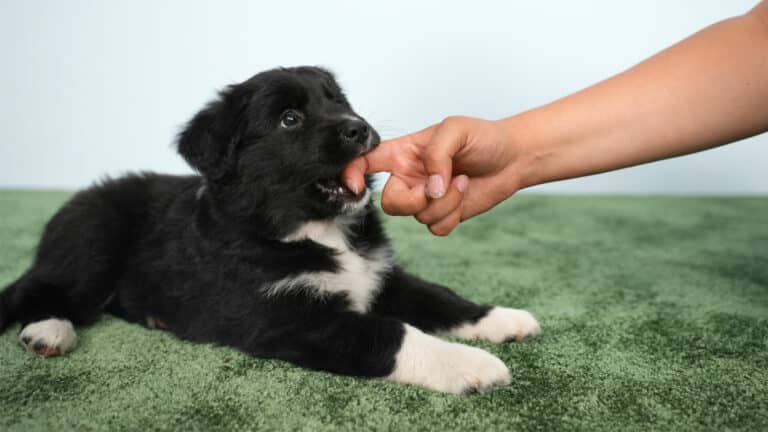
Bite inhibition is an important part of puppy training. Puppies often explore the world with their mouths and can sometimes bite too hard when playing or exploring. Here are some tips on how to teach your puppy to be gentle:
1) Let your puppy play with other dogs:
Puppies often learn how to use their teeth properly from other dogs. If he bites too hard, the other dog will probably stop playing or back away, showing your puppy that he has gone too far.
2) Give a clear signal:
If your puppy bites too hard while playing or cuddling, give a loud, painful "ouch." Then stop the play for a few seconds. This can help your puppy understand that he is biting too hard and that the play will stop.
3) "Gentle" practice:
You can teach your puppy the "Gently" command. Hold a treat in your closed hand and only let him take it when he gently licks or sniffs it, not when he bites.
4) Deflect the biting:
Puppies have a natural need to chew, especially during teething. Make sure your puppy has a wide variety of chew toys to satisfy his urge to chew.
5) No hand and foot games:
Don't play with your puppy by moving your hands or feet quickly in front of his face. Instead, use toys for tugging and chasing games.
6) Reward gentle behavior:
If your puppy plays gently and doesn't bite, reward that behavior with praise, treats or more playtime.
Learning bite inhibition takes time and patience. Every puppy is different, so be consistent and positive in your training. If biting becomes a serious problem or your puppy exhibits aggressive behavior despite training, consider seeking the help of a professional dog trainer.
In this article you will find even more information:
Bite inhibition: how to stop your puppy from biting
Puppy does not want to go for a walk
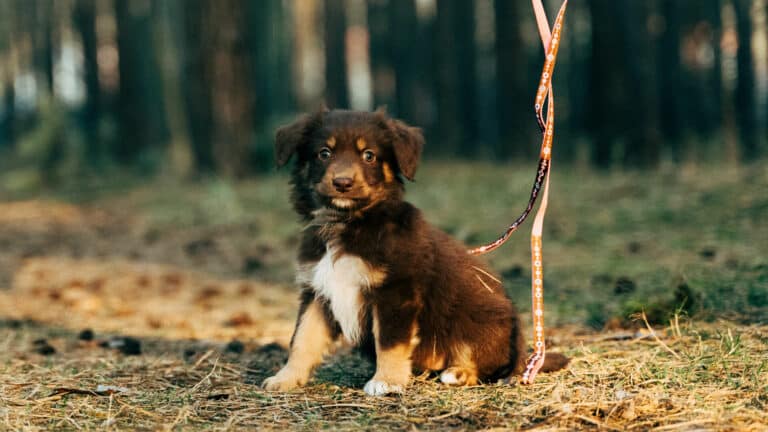
There can be many reasons why a puppy does not want to be on a leash. He may be fearful, overwhelmed by the new environment, or simply not used to being on a leash. Here are some tips on how to help your puppy get used to walks:
1) Start slowly:
For a puppy, the outside world can be overwhelming. Start with short walks in a quiet environment and gradually increase the duration and amount of walks.
2) Make it positive:
Associate the walk with positive experiences. Reward your puppy with praise and treats when he successfully walks on the leash. You can also associate playtime or feeding time with walks so he associates them with something pleasant.
3) Practice walking on a leash at home:
Before you take your puppy outside, you can practice walking on a leash in a familiar environment like your home or yard.
4) Use the right tableware:
Some puppies are uncomfortable or restricted by certain types of leashes or harnesses. Experiment with different options to find out what your puppy likes best.
5) Be patient and consistent:
Your puppy needs time to get used to being walked. Don't expect him to walk perfectly on the leash right away. Reward small progress and stay consistent in training.
Remember that walks are not only a way to keep your puppy physically occupied, but also an important opportunity for him to explore new environments and have new experiences. With patience and a positive attitude, you can help your puppy make walking an enjoyable activity.
You can find more on this topic in this article:
When Your Puppy Doesn’t Want to Walk: Reasons and Tips to Help
Stay alone
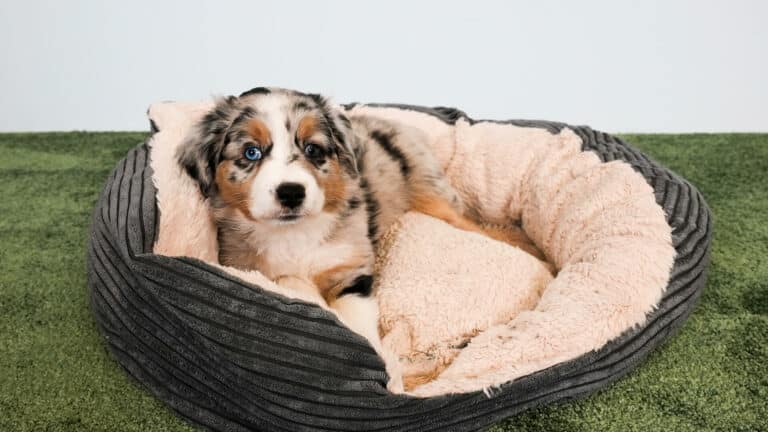
For many puppies, staying alone is a challenge, but it's an important skill for them to learn. Here are some steps to teach your puppy to stay alone:
1) Create a safe space:
Create a space where your puppy feels safe and comfortable. This can be a room with a baby gate or a large cage with enough space for a place to sleep, a water bowl and toys.
2) Start with short absences:
Leave the room for a few seconds when your puppy is awake and calm. Return before he becomes restless or begins to cry. This way he learns that you always come back.
3) Lengthen the time slowly:
Once your puppy is comfortable with short absences, slowly increase the time. Increase from a few seconds to a minute, then to two minutes, five minutes, and so on.
4) Distraction:
Give your pup a toy or chew to keep him occupied when you're not around. There are many toys on the market that are filled with treats and designed to keep dogs occupied.
5) Be quiet:
Make your coming and going quiet and unobtrusive. Making too much noise can increase your puppy's anxiety.
6) Leave the room when your puppy is busy:
Try to leave the room when your puppy is busy doing something, such as chewing a toy or eating.
7) Ignore the crying (to some degree):
If your puppy starts crying as soon as you leave the room, it is important that you do not return immediately or he will learn that crying will bring you back. However, this method should not be overused, as continued crying and stress can be harmful to your puppy.
8) Positive reinforcement:
If your puppy stays calm while you're gone, reward him with praise or a treat.
It is important to remember that every animal is different and some will need more time than others to learn to stay alone. Be patient and consistent and remember that it is a big adjustment for your puppy.
Too theoretical for you? If you prefer a visual approach, our Hundeo app offers step-by-step video instructions to teach your dog the sit command and more. Learn more about the Hundeo app.
Teething puppy
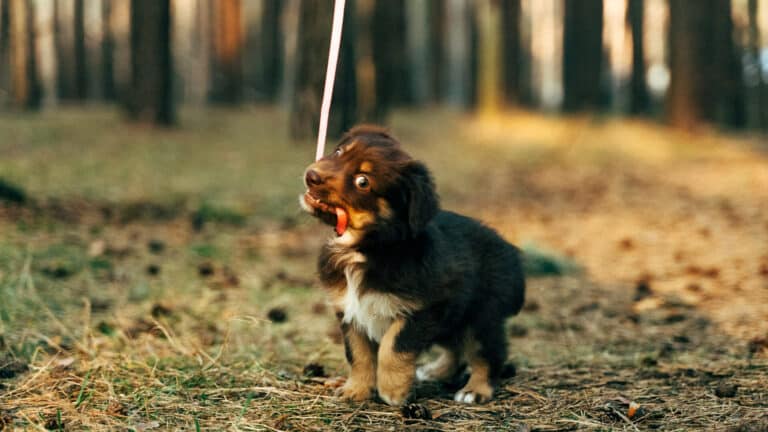
When your puppy is teething, there are a few things you can do to help him through this stage:
1) Provide toys:
Offer your puppy appropriate chew toys designed specifically for teething. These toys relieve gum pain and keep your puppy from chewing on inappropriate objects.
2) Use cooling toys or wipes:
Put toys or wipes in the refrigerator or freezer to cool them down. Chewing on cool items can help numb the gums and calm the puppy.
3) Massage the gums:
Gently massage your puppy's gums with your finger. Make sure your hands are clean before putting them in your puppy's mouth.
4) Distraction and employment:
Provide your puppy with enough activity and distraction to take his mind off his teething pain. Play with him, practice obedience exercises, or keep him busy with other activities that focus his attention on something positive.
5) Avoid negative reinforcement:
Punishing or scolding is not effective and can make your puppy's chewing behavior worse. Focus on encouraging proper chewing on appropriate objects and gently redirecting unwanted chewing.
6) Consult a veterinarian:
If your puppy is excessively restless during teething or shows signs of pain or inflammation, it is advisable to see a veterinarian. The veterinarian can examine the puppy's condition and provide recommendations or pain relievers if necessary.
It is important to know that the teething phase is over and your puppy will gradually get his permanent teeth. In the meantime, however, it is important to support and reassure him during this time.
Health and nutrition
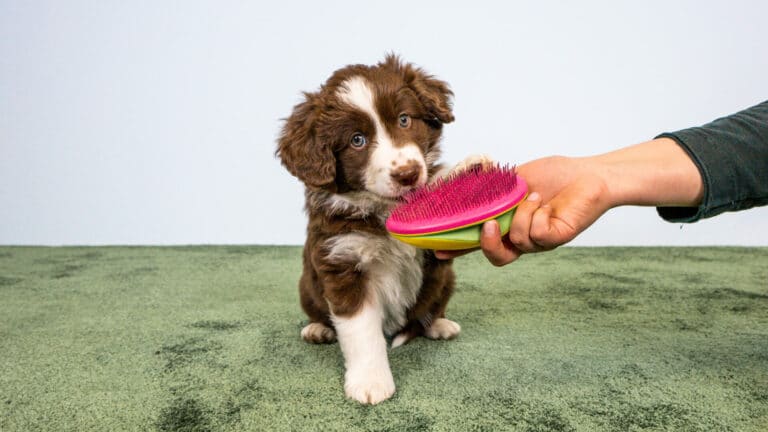
Your puppy's health and nutrition are very important for him to grow up to be a healthy and happy dog.
Regular vet visits are important for your puppy's health. Your puppy should be taken to the vet regularly to make sure he has received all necessary vaccinations and is healthy. Your vet will also suggest a deworming schedule and give you advice on nutrition and training if needed.
Make sure your puppy gets plenty of exercise. This will help him stay healthy and get rid of excess energy. The amount and type of exercise depends on the age, breed and health of the puppy.
Dental hygiene is important to prevent tooth and gum disease. Brushing, special chews and dry food can help maintain your puppy's dental health.
For your dog's dental hygiene, check out this article:
Dental care for dogs (7 important tips for care)
Use flea, tick and heartworm preventatives as recommended by your veterinarian.
Do not let your puppy climb stairs alone for the first few months. This way you can be sure that no late effects will occur.
However, get your dog used to climbing stairs sooner or later. If they are carried for a long time, they may later become afraid of climbing stairs.
You can find more exciting information in this article:
Can Puppies Go Up And Down Stairs?
For your puppy's diet, choose a high-quality puppy food that is specially formulated to meet the nutritional needs of puppies. It should contain balanced amounts of protein, fat, carbohydrates, vitamins and minerals.
Feed your puppy several times a day. Puppies have small stomachs and need more meals than adult dogs. Your veterinarian can help you set up an appropriate feeding schedule.
Avoid certain foods. Some foods can be toxic to dogs, such as chocolate, onions, garlic, grapes, raisins, alcohol, caffeine, and certain artificial sweeteners (e.g., xylitol). Do not give your puppy these foods.
Keep your pup lean. Obesity can lead to health problems such as heart disease, diabetes and joint problems. Make sure your puppy gets an appropriate amount of food and doesn't gain too much weight.
Your puppy's health and nutrition is an ongoing task that requires attention and commitment. But with proper care and a healthy lifestyle, you can help ensure that your puppy lives a long, healthy and happy life.
Games are
Playing with your puppy is not only fun, but also helps develop his physical, mental and social skills. Here are some puppy games you can try:
- Retrieval: Start with a soft toy and throw it from a safe distance. Encourage your puppy to fetch the toy and bring it back to you. Don't forget to praise him for it!
- Hide and seek: Hide a toy or treat and let your puppy search for it. This encourages his problem-solving skills and keeps him mentally active.
- Tugging game: A tug toy can be a great way to teach your puppy the "off" command and strengthen his jaw muscles. Make sure the tug toy is sturdy enough not to break.
- Catching soap bubbles: Many puppies love to snap at bubbles. It's great exercise and can be a lot of fun. Make sure the bubble solution is non-toxic and safe for pets.
- Food ball: Put food or treats in a food ball. While your puppy is trying to get to the food, he will be challenged mentally and physically.
Game tips
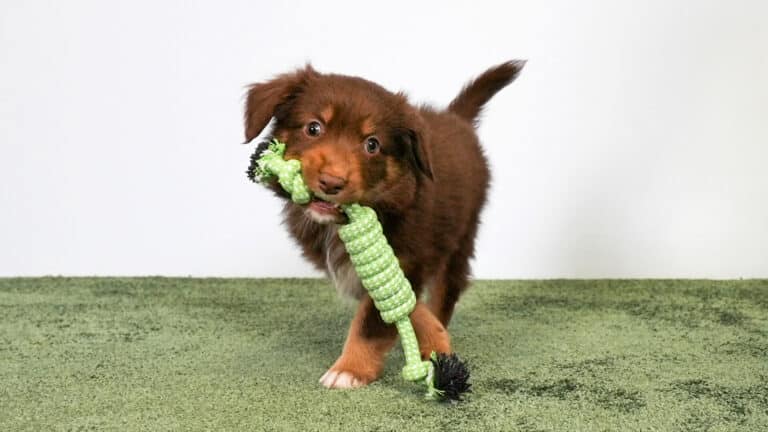
When playing with your puppy, keep the following in mind:
1. avoid overexertion: Puppies have a lot of energy, but they also need a lot of rest. Make sure that playtime is short and that your puppy has enough time to rest afterwards.
2. safety: Make sure all toys are safe and large enough to avoid swallowing or injury. Play should take place in a safe environment, away from dangerous objects or high places from which your puppy could fall.
3. stick to rules: Set rules for the game and stay consistent. For example, if your puppy starts biting your hand instead of the toy during a game of tug, the game should be stopped immediately.
4. integrate the training: Use playtime to teach your puppy new commands or practice familiar ones.
5. positive reinforcement: Don't forget to praise and reward your puppy during play, especially when he follows the rules and exhibits the desired behavior.
Remember that the goal of play is fun and learning. It should be a positive experience for you and your puppy.
You want to know more about puppy games, then read this article:
Puppy games: How to have fun together!
10 basic rules
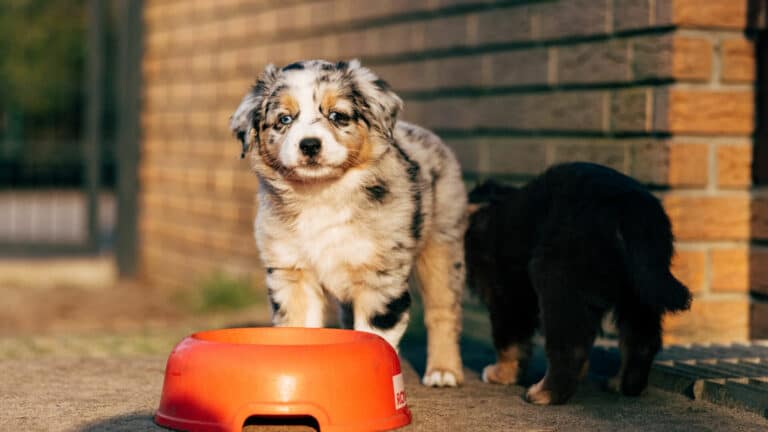
There are a number of basic rules that can be helpful and efficient in raising a puppy. They can serve as a guide for a safe and harmonious coexistence.
# Basic rule 1: Consistency is the key
If you expect your puppy to behave a certain way, you need to be consistent. This means that you should use the same commands and apply rewards or corrections consistently. Consistency helps your puppy understand what is expected of him.
# Basic rule 2: Positive reinforcement:
Always reinforce good behavior positively, whether through praise, petting, or treats. This makes it more likely that the desired behavior will be repeated.
# Basic rule 3: Be patient:
Puppies don't learn overnight. There will be setbacks and some things will take longer than others. Be patient and celebrate small successes.
# Basic rule 4: Early socialization:
Puppies should be socialized early and safely. This means familiarizing them with different people, dogs, places and situations. This helps to avoid fears and aggression later in life.
# Basic rule 5: Avoid corporal punishment:
Physical punishment is counterproductive and can lead to fear and aggression. Instead, you should ignore unwanted behavior or correct your puppy with a calm, firm voice.
# Basic rule 6: Set clear boundaries:
Your puppy should know what he is allowed and what not. For example, whether he is allowed on the sofa or not, which rooms he can enter and so on.
# Basic rule 7: Provide enough exercise and mental stimulation:
Make sure your puppy gets enough exercise and mental stimulation. This can be done through games, training, walks or toys.
# Basic rule 8: Daily training:
Practice makes perfect! Short, daily workouts can be more effective than longer, infrequent ones.
# Basic rule 9: Don't leave your puppy alone for too long:
Puppies are social animals and can develop anxiety if left alone for too long. Try to slowly increase the time spent alone to avoid separation anxiety.
# Basic rule 10: Health is important:
Good health is the foundation for happy and successful training. Make sure your puppy receives all the necessary vaccinations and preventive examinations and is fed a balanced diet.
Frequently Asked Questions
Do not give your puppy food or treats from the table or during meals. Begging will be reinforced if the puppy is rewarded from time to time. Give clear instructions to your family or roommates that they should not give the puppy anything from the table either.
Keep a regular feeding schedule for your puppy. That way, he gets his meals at the appointed time and doesn't expect to get extra food by begging.
Completely ignore your puppy's begging behavior. Don't give him attention, petting, or verbal reinforcement when he begs. Even if it's hard, it's important to be firm.
Assign your puppy a specific area to eat, such as a feeding station or a specific spot in the kitchen. Teach him that the food is only available in that place and that he doesn't have to look for it elsewhere.
Encourage your puppy to exhibit alternative behaviors instead of begging. Give him a specific toy or chew item when you eat to distract and engage him.
Train your puppy with basic commands like "sit" or "down". When he has mastered these commands, you can ask him to sit down while eating or to retreat to a certain place.
Yes, even a well-behaved dog should be trained. By training, you can ensure that your dog's mental and physical abilities are improved and that your dog is properly exercised. In addition, training provides an ideal setting to strengthen your relationship and trust in each other.
Yes and no. Some breeds are known for their high energy or independence and therefore require more training and attention than others. Also, just like people, dogs have different personalities and learn at different rates. At the same time, basic commands are the foundation of a good relationship and should be mastered by every dog.
Yes, it is advisable to break your puppy's habit of jumping up. Jumping up can be uncomfortable for some people and even dangerous in some situations, especially when your puppy gets bigger and stronger.
If your puppy tries to jump on you, ignore him completely. Turn away, don't look at him, and don't give him any attention, including verbal or physical reinforcement.
Instead, teach your puppy an alternative behavior that he can use to greet you. For example, teach him to sit down or put all four paws on the floor to get attention.
When your puppy sits down or stays still instead of jumping up, reward him with praise, petting or a treat. Positive reinforcement for desired behavior can help reinforce it.
Conclusion
Puppyhood is an exciting and challenging time of growth and learning. With a well thought out education, you can help your puppy become a healthy, happy and well behaved dog.
The basics of puppy training are consistency, patience and understanding your puppy's needs. It's important to teach your puppy simple commands, get him used to the leash, housebreak him, and teach him bite inhibition.
Don't forget that training should be fun, too. Puppy games are a great way to strengthen your bond with your puppy, develop his skills, and use up his energy at the same time. Proper nutrition and regular vet visits are also important to ensure your puppy's health.
Raising your puppy may seem overwhelming at first, but with the right strategies and a positive attitude, you can overcome the challenges.
Remember that every dog is different - what works for one dog may not work for another.
The key is to know your puppy, understand his needs and give him lots of love and care. It's a journey that will be worth it for you and your puppy.
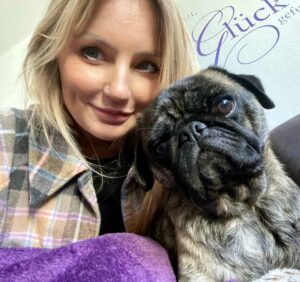
I'm editor-in-chief at Hundeo and when it comes to dogs, my heart beats faster. My goal is to publish the best dog guides on the web. There is a lot of passion in every article and I welcome any feedback to constantly improve our content.
Share Now:

